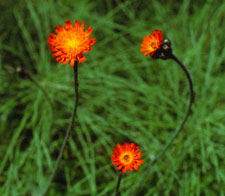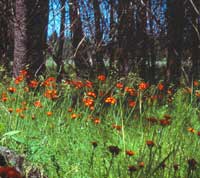Orange hawkweed
Hieracium aurantiacum
Keys to Identification
- Orange hawkweed is a perennial member of the Sunflower family (Asteraceae)
- It likes moist grassy areas and can be found along creeks, in meadows, and along rights-of-way
- Reproduces by runners and by seed
- Each bright orange flower is between 1/2 to 1 inch wide. They are grouped at the top of a slender stem and tend to close up when it is shady, making the plants difficult to see
- Hairy leaves are found at the base of the plant
- Orange hawkweed is found in only a few places in Colorado and is on the A List, requiring eradication
This information courtesy of the Colorado Natural Areas Program
Family
Sunflower (Asteraceae)
Other Names
Devil’s paintbrush
USDA Code
HIAU
Legal Status
Colorado Noxious Weed List A
Notify your county weed supervisor if you find this plant!
Identification
Lifecycle
Perennial
Growth form
Forb
Flower
Orange in groups of up to 13 at the end of stem. June-July.
Seeds/Fruit
With papus.
Leaves
Basal. Dark green hairy.
Stems
Fine, leafless. 1-2 ft tall with stiff hairs.
Roots
Fibrous spreading with stolons at nodes.
Seedling
Seedling leaves have bristly hairs.
Similar Species
Exotics
Yellow hawkweed.
Natives
Native hawkweeds and false dandelion.
Impacts
Agricultural
Infests hay fields, animals will not feed.
Ecological
Forms mats that prevent other plants from growing.
Habitat and Distribution
General requirements
Likes shady areas. Can be found in grassy areas, moist pastures, stream banks.
Distribution
Found in a number of counties in Colorado in small populations. Also found throughout northern US.
Historical
Native to Europe.
Biology/Ecology
Life cycle
Perennial plants form rosettes in spring and early summer, spread primarily through stolons. Plants flower in June-July.
Mode of reproduction
Seed, stolons, rhizomes.
Seed production
Each stem may produce thousands of seeds.
Seed bank
Not known.
Dispersal
Wildflower seed mixes, wind, water and possibly animals.
References
Callihan, R.H., L.M. Wilson, J.P. McCaffery, T.W. Miller, 1997. Hawkweeds. Pacific Northwest Extension Publication 499. Cooperatively published by the University of Idaho Cooperative Extension, Oregon State Cooperative Extension Service, Washington State Cooperative Extension and the U.S. Department of Agriculture.
Hoffman, R. & K. Kearns, Eds.. 1997. Wisconsin Manual of Control Recommendations for Ecologically Invasive Plants. Wisconsin Dept. Natural Resources. Madison, Wisconsin.. 102pp.
Whitson, T.D. (Ed.) et al.. 1996. Weeds of the West. Western Society of Weed Science in cooperation with Cooperative Extension Services, University of Wyoming. Laramie, Wyoming. 630pp.


Photos courtesy of La Plata County

